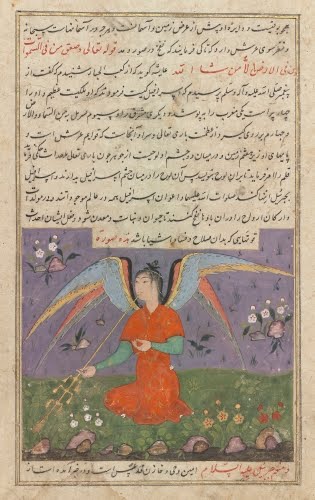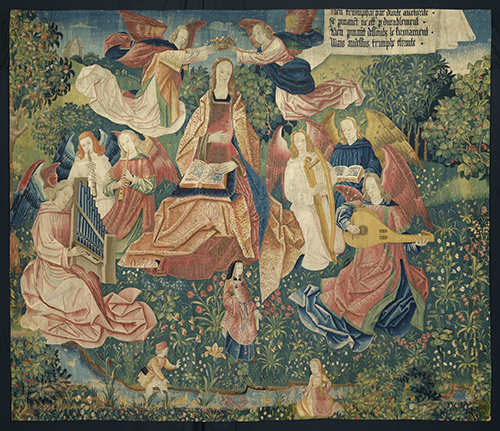A Multicultural Proclaimer: Safavid Dynasty
Westerners usually think of the Archangel Gabriel in terms of Christmas cards depicting the Annunciation, when he proclaimed to Mary that she would conceive Jesus. Well, it turns out that he was a multicultural proclaimer, serving as God’s messenger in Christian, Jewish, Muslim, and other faiths. The angel is mentioned several times in the Qur’an, although there are various interpretations of his status by scholars. However, scholars all agree that it was Gabriel (Jibril, or Jibrail) who made the really big announcement to Muhammad that he was chosen to be a prophet by God.
 |
| Iran, The Archangel Gabriel, page from a dispersed manuscript of Wonders of Creation by Qazvini, 1500s. Ink and opaque watercolor on paper, 10 7/8" x 7" (27.7 x 18 cm). © 2017 Museum of Fine Arts, Boston. (MFAB-1407) |
In the ninety-sixth chapter of the Qur’an (96:1-5), the archangel Gabriel appears to Muhammad while he is in the wilderness of Hira (near Mecca) meditating and trying to figure out his spiritual life away from all of the evils in the world. Gabriel basically tells Muhammad that God needs him to put forth God’s message, and to write down God’s teachings. The archangel helped him overcome his protests that he could not read or write, ultimately convincing Muhammad, “Read in the name of your lord and cherisher who created…He who taught the use of pen; Taught man that which he did not know.”
This passage, in which Muhammad is instructed to write the Qur’an, more or less, is so interesting in light of how significant calligraphy became in the art forms of Islamic lands. The emphasis on the written word in the Qur’an is so strong that, by the Middle Islamic Period (ca. 750–1258), literacy in Islamic lands was greater than in Western Europe.
So, this image of Gabriel is not simply the result of the influence of Western European manuscripts from the Renaissance, because angels already existed in Islamic thought. In fact, winged, supernatural beings in human form have existed for thousands of years in the art of the Middle East. This figure of Gabriel bears the typical stylistic traits of Safavid Iranian court painting in the attenuated, elegant figure in a shallow landscape that resembles the millefleur designs of French Renaissance tapestries. The wings resemble paintings of seraphim, the angels of upper high heaven in European paintings.
 |
| France, Triumph of Eternity from the Château de Chaumont Tapestry series, from the Loire Valley, ca. 1512–1515. Wool and silk, 125 ¾" x 148 5/8" (319.3 x 377.6 cm). © 2017 Cleveland Museum of Art, Gift of various donors, by exchange. (CM-492) |
Book illustration became a dominant form of artistic expression during the Middle Period. Although the Qur’an forbids the representation of any being with a soul, secular books began to portray religious scenes. This image comes from Abu Yahya Zakariya ibn Muhammad Ibn Mahmud-al-Qazvini’s (ca. 1203–1283) book Wonders of Creation. This book, divided in two sections, focuses on celestial phenomena (such as angels, constellations, and planets) and the earthly world (geography, ethnology, zoology, and botany). Qazvini, educated mostly in Bagdhad, was primarily a compiler of information from various sources.
In many ways, this book is similar to the Book of the Marvels of the World (Livre des Merveilles du Monde), a French compilation of numerous sources on similar subjects, both religious and scientific, ca. 1460. Talk about a global village. Wonders of Creation became very popular in Mughal India (1526–1756), where the Safavid style of illustrating books had great influence on Mughal painting.
Correlations to Davis programs: Experience Painting: 1; Discovering Art History: 4.7, 7.3; Discovering Art History Digital: 4.7, 7.3; The Visual Experience: 14.2


Comments